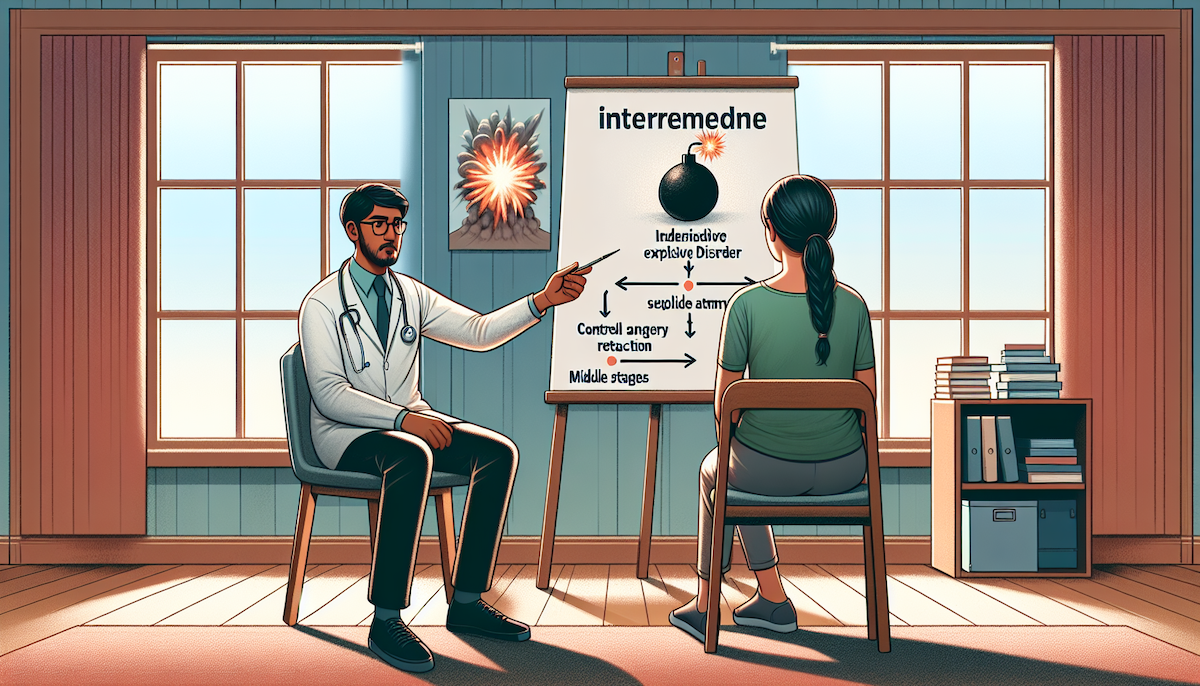Understanding Intermediate Explosive Disorder (IED)
Intermediate Explosive Disorder (IED/IE) stands as a formidable challenge within the mental health landscape, characterized by sudden episodes of unwarranted anger and aggressive behavior. This article embarks on a comprehensive journey to unravel the complexities of IED, aiming to illuminate the paths for those affected and the professionals dedicated to their care. By dissecting the clinical presentation, etiology, and available treatment approaches, we endeavor to offer a beacon of understanding and hope amidst the storm of confusion that often surrounds this condition.

intermediate explosive disorder
Navigating the Storm: Understanding Intermediate Explosive Disorder
Intermediate Explosive Disorder
- Introduction to Intermediate Explosive Disorder
- – Overview of the disorder
- – Importance of understanding it
- Clinical Presentation and Diagnosis
- – Symptoms and criteria (referencing DSM-5)
- – Diagnostic processes
- Etiology and Risk Factors
- – Biological factors (genetic, neurological)
- – Environmental and psychological influences
for Further understanding – psycho-social-medical perspectives of Intermediate Explosive Disorder (IED)
- Comparison with Related Disorders
- – Differentiating from similar conditions
- – Key distinctions in symptoms and treatment
- Treatment Approaches
- – Medication options and effectiveness
- – Psychotherapeutic interventions (Cognitive Behavioral Therapy, others)
- Coping Strategies and Support Systems
- – Self-help strategies
- – The role of family and community support
- Case Studies and Real-Life Implications
- – Analysis of documented cases
- – Impact on personal and social life
- Conclusion and Future Directions
- – Summarizing key takeaways
- – Potential areas of future research and treatment advancements
- FAQ’s
1. Introduction to Intermediate Explosive Disorder
Intermediate Explosive Disorder (IED) is a mental disorder characterized by recurrent episodes of impulsive and aggressive behavior. Individuals with IED often experience intense anger or rage that is disproportionate to the provoking event. This disorder may manifest in verbal or physical aggression towards others or destruction of property.
Understanding IED and its underlying causes is crucial for several reasons. Firstly, it allows for early identification and intervention, which can help prevent the escalation of aggression and reduce harm to oneself and others. Secondly, understanding IED can help remove the stigma associated with these explosive outbursts, fostering empathy and support for affected individuals. Lastly, a comprehensive understanding of IED enables healthcare professionals to develop effective treatment strategies and support options for these individuals.
2. Clinical Presentation and Diagnosis
In order to diagnose IED, healthcare professionals refer to the criteria outlined in the fifth edition of the Diagnostic and Statistical Manual of Mental Disorders (DSM-5). The DSM-5 defines the following symptoms and criteria for diagnosing IED:
- a) Recurrent episodes of verbal or physical aggression that is grossly out of proportion to the provocation or stressor.
- b) The aggression is impulsive, with little to no forethought or planning.
- c) Additional behavioral criteria include destructiveness, assaultiveness, or hostility.
- d) The aggressive episodes are not better explained by another mental disorder, substance use, or a medical condition.
- e) The individual must have reached the age of six years old in order to be diagnosed with IED.
The diagnostic process for IED involves a comprehensive psychiatric evaluation. This evaluation typically consists of a thorough medical and psychological history, including information about the frequency, severity, and duration of aggressive episodes. Information is also gathered regarding the individual’s personal and family medical history, as well as any potential traumas or stressors that may contribute to the development of IED.
It is important to note that IED is not the only explosive disorder mentioned in the DSM-5. Other related explosive disorders include Intermittent Explosive Syndrome and Explosive Personality Disorder. While these disorders share some similarities to IED, there are specific criteria that distinguish them from one another. Mental health professionals use the DSM-5 as a guide to differentiate and accurately diagnose these various explosive disorders.
By better understanding the clinical presentation and diagnostic criteria of IED, healthcare professionals can provide appropriate interventions and develop personalized treatment plans for individuals suffering from this disorder. Early diagnosis and intervention are essential in managing and treating IED, reducing the risk of harm to oneself and others.
3. Etiology and Risk Factors
Etiology refers to the causes or origins of a specific disorder, while risk factors are factors that increase the likelihood of developing the disorder. In the case of Intermediate Explosive Disorder (IED), both biological factors and environmental and psychological influences contribute to the etiology and risk factors of the disorder.
Biological Factors (Genetic, Neurological):
Research suggests that there may be a genetic predisposition to IED. Studies have shown that individuals with a family history of aggression or anger-related disorders are more likely to develop IED themselves. This indicates that there may be a genetic component to the disorder. Additionally, neurological factors may play a role in IED. Specifically, abnormalities in certain areas of the brain, such as the prefrontal cortex and amygdala, have been associated with impulsive and aggressive behaviors seen in individuals with IED.
Environmental and Psychological Influences:
Environmental factors, such as early exposure to violence or maltreatment, can significantly contribute to the development of IED. Traumatic experiences, especially during childhood, can lead to a heightened stress response and difficulty regulating emotions, which can manifest as explosive outbursts. Additionally, individuals who grow up in aggressive or violent environments may learn aggressive behaviors as coping mechanisms, further increasing their risk for IED.
Psychologically, individuals with IED often have difficulties with anger management and impulse control. They may have a lower tolerance for frustration and experience heightened irritability and impulsivity, which can lead to explosive episodes. Certain psychological disorders, such as conduct disorder, oppositional defiant disorder, and attention-deficit/hyperactivity disorder (ADHD), are also frequently comorbid with IED, suggesting a shared underlying vulnerability.
For Further Understanding: The Psycho-Social-Medical Perspectives of Intermediate Explosive Disorder (IED)
Intermediate Explosive Disorder (IED) is a multifaceted condition that cannot be fully understood through a single lens. To grasp its complexity, it’s essential to examine the psycho-social-medical perspectives that contribute to its onset, manifestation, and treatment. This comprehensive approach sheds light on the interplay between psychological factors, social dynamics, and biological underpinnings, offering a holistic view of IED.
Psychological Perspectives
The psychological dimension of IED focuses on the internal processes and emotional dysregulation that characterize the disorder. Individuals with IED often exhibit a heightened response to stress or perceived threats, leading to disproportionate anger or aggression. This can be traced back to various factors, including unresolved trauma, maladaptive coping mechanisms, and underlying mental health conditions such as anxiety or depression. Cognitive-behavioral therapy (CBT) and other psychotherapeutic interventions are pivotal in addressing these psychological aspects, aiming to develop healthier coping strategies and improve emotional regulation.
Social Perspectives
Social influences play a crucial role in the development and expression of IED. The disorder can be exacerbated by environmental stressors, such as familial conflict, societal pressures, or a history of exposure to violence. Social support, on the other hand, serves as a protective factor, providing individuals with a sense of belonging and resources for coping. Understanding the social context of those affected by IED is vital in crafting interventions that not only address the individual’s needs but also foster a supportive environment conducive to healing and growth.
Medical Perspectives
Biologically, IED has been linked to genetic predispositions and neurological anomalies. Research suggests that abnormalities in the brain regions responsible for regulating emotions, such as the amygdala and the prefrontal cortex, may contribute to the impulsive and aggressive behavior seen in IED. Furthermore, neurotransmitter imbalances, particularly in serotonin levels, have been associated with an increased risk of the disorder. Medications that target these imbalances, alongside psychotherapy, can offer significant benefits in managing the symptoms of IED.
Integrating Perspectives for a Comprehensive Approach
Effective treatment and understanding of IED necessitate an integration of psycho-social-medical perspectives. This approach acknowledges the disorder’s complexity and ensures that interventions are tailored to address the myriad factors contributing to its manifestation. By considering the psychological, social, and medical dimensions of IED, healthcare providers can offer more personalized and effective care, ultimately leading to better outcomes for those affected.
In conclusion, the psycho-social-medical framework offers a deep dive into the intricacies of Intermediate Explosive Disorder, highlighting the importance of a multi-dimensional approach in comprehending and addressing this challenging condition. By embracing this holistic perspective, we can pave the way for more nuanced interventions and a greater understanding of IED, fostering a future where individuals impacted by the disorder can lead more balanced and fulfilling lives.
4. Comparison with Related Disorders
Differentiating from similar conditions:
One related condition often compared to IED is intermittent explosive syndrome. While these two terms are sometimes used interchangeably, there are some key differences between the two. Intermediate Explosive Disorder is a recognized mental disorder listed in the Diagnostic and Statistical Manual of Mental Disorders (DSM-5). On the other hand, intermittent explosive syndrome is a broader term used to describe uncontrolled aggressive outbursts that do not necessarily meet the diagnostic criteria for IED.
Key Distinctions in Symptoms and Treatment:
The key distinction in symptoms between IED and other related disorders lies in the severity and frequency of explosive outbursts. Individuals with IED have recurrent episodes of impulsive, aggressive behavior that is grossly out of proportion to the triggering event. These outbursts typically result in physical or emotional harm to others or damage to property. Treatment for IED often involves a combination of psychotherapy, such as anger management and cognitive-behavioral therapy (CBT), and medication, such as selective serotonin reuptake inhibitors (SSRIs) or mood stabilizers.
It is important to note that while IED shares some similarities with explosive personality disorder and explosive anger disorder, these terms are not recognized as specific disorders in the DSM-5. Instead, IED captures the symptoms and behaviors associated with these conditions. DSM-5 criteria should be used to diagnose and treat individuals with IED.

5. Treatment Approaches for Intermediate Explosive Disorder (IED) or Intermittent Explosive Syndrome
Individuals with Intermediate Explosive Disorder (IED), also known as Intermittent Explosive Syndrome, experience recurrent episodes of impulsive aggression, which can lead to physical harm or destruction of property. These episodes are characterized by a failure to resist aggressive impulses, resulting in sudden verbal or physical outbursts disproportionate to the triggering event. Treatment for IED typically involves a combination of medication options, psychotherapeutic interventions, coping strategies, and support systems. In this article, we will explore these treatment approaches in detail.
1. Medication options and effectiveness:
Medication can play a crucial role in managing the symptoms of IED and reducing the frequency and intensity of explosive episodes. The following medications may be prescribed by healthcare professionals:
- Selective Serotonin Reuptake Inhibitors (SSRIs): SSRIs, such as fluoxetine or sertraline, are commonly used antidepressants that have shown effectiveness in reducing aggressive and impulsive behaviors.
- Mood Stabilizers: Medications like lithium or divalproex sodium may be prescribed to stabilize mood swings and manage aggression.
- Anti-anxiety Medications: Benzodiazepines like lorazepam or clonazepam may be utilized to reduce anxiety and prevent the escalation of aggressive impulses.
- Antipsychotics: Certain antipsychotic medications, such as olanzapine or risperidone, may be prescribed to control aggression and irritability.
It is important to note that the effectiveness of medication may vary from person to person, and finding the right dosage and combination of medications often requires close monitoring and adjustments by a healthcare provider.
2. Psychotherapeutic interventions:
Psychotherapeutic interventions, particularly Cognitive Behavioral Therapy (CBT), have been proven effective in treating IED. CBT focuses on identifying and modifying dysfunctional thoughts, beliefs, and behaviors that contribute to explosive episodes. Other psychotherapeutic techniques that can be beneficial include:
- Anger Management Therapy: This form of therapy aims to teach individuals healthier coping strategies for managing anger, improving emotional regulation, and enhancing problem-solving skills.
- Dialectical Behavior Therapy (DBT): DBT can be beneficial in helping individuals with IED manage difficult emotions, develop interpersonal skills, and prevent impulsive and aggressive responses.
- Stress Management Techniques: Various stress-reducing techniques, such as relaxation exercises, mindfulness, and breathing exercises, can be helpful in preventing or minimizing anger triggers.
Psychotherapeutic interventions can provide individuals with skills and tools to better manage their emotions and responses, ultimately reducing the frequency and severity of explosive episodes.
6. Coping Strategies and Support Systems:
In addition to medication and psychotherapy, individuals with IED can benefit from adopting coping strategies and establishing support systems. Here are some strategies to consider:
1. Self-help strategies:
- – Self-awareness: Developing an understanding of personal triggers and early signs of anger can help individuals take proactive steps to prevent explosive episodes.
- – Relaxation techniques: Practicing activities like deep breathing, meditation, or yoga can help individuals calm themselves during moments of anger or stress.
- – Time-out: Taking a short break from a potentially provocative situation can give individuals time to regain control and think more rationally.
2. The role of family and community support:
- – Family therapy: Including family members in therapy sessions can help improve understanding, communication, and dynamics within the family unit.
- – Support groups: Joining support groups or engaging in group therapy with others who have experienced similar challenges can provide validation, empathy, and a sense of community.
Open communication and a supportive environment involving loved ones, friends, and community members can significantly contribute to the overall well-being of individuals with IED.
In conclusion, treatment approaches for Intermediate Explosive Disorder (IED) involve a combination of medication options, psychotherapeutic interventions, coping strategies, and support systems. Medications like SSRIs, mood stabilizers, and antipsychotics can help manage symptoms, while psychotherapeutic interventions like CBT, anger management therapy, and stress management techniques can equip individuals with skills to better regulate their emotions. Implementing self-help strategies and establishing strong support systems can further enhance the effectiveness of treatment. It is essential for individuals with IED to seek professional help to develop a comprehensive treatment plan tailored to their specific needs.
7. Case Studies and Real-Life Implications
Analysis of Documented Cases:
Intermediate Explosive Disorder (IED), also known as intermittent explosive disorder, is a psychiatric condition characterized by recurrent episodes of impulsive, aggressive, and violent behavior. To better understand this disorder, numerous case studies have been conducted, providing valuable insights into its manifestations, causes, and potential treatment approaches.
The Story of Alex: Navigating a Legacy of Pain
Alex, a 32-year-old man, found himself caught in a tempest of unbridled aggression. His life, marred by severe episodes of violence, saw him causing not just physical harm to those around him but also leaving a trail of destruction in his wake. The roots of Alex’s struggles lay buried in his childhood—a time shadowed by abuse and neglect. These early experiences, characterized by a lack of safety and love, planted the seeds for what would later be diagnosed as Intermediate Explosive Disorder (IED).
The journey to understanding Alex’s condition revealed a man fighting an internal battle, where triggers like perceived criticism or frustration in relationships acted as igniters to his explosive reactions. These outbursts, though brief, had profound implications on his personal and professional life, leading to strained relationships and isolation. It was in the intricate process of therapy that Alex began to untangle the web of his past, recognizing the impact of his childhood experiences on his current behavior. Through a tailored treatment plan, incorporating both psychotherapy and medication, Alex embarked on a path towards healing, learning to navigate his emotions and triggers in a healthier manner.
The Journey of Sarah: From Self-Loathing to Self-Compassion
Sarah, at 45, carried the weight of her anger inward. Her episodes of explosive anger, unlike Alex’s, turned towards herself, manifesting in a cycle of intense frustration and self-harm. Behind her struggle lay a history of childhood trauma, compounded by an enduring battle with post-traumatic stress disorder (PTSD). These factors intertwined, creating a volatile mix that fueled her self-directed outbursts.
For Sarah, feelings of inadequacy and self-loathing acted as catalysts, triggering episodes where the only outlet she found was in harming herself. This pattern of behavior was a cry for help, a physical manifestation of her internal turmoil. The turning point for Sarah came through her courageous decision to seek help, leading to the diagnosis of IED. Her treatment journey was marked by the adoption of psychotherapeutic interventions, including Cognitive Behavioral Therapy (CBT), which aimed at addressing her deep-seated trauma and teaching her healthier ways to cope with frustration and self-directed anger.
Through therapy, Sarah gradually began to peel away the layers of pain and anger, learning to replace self-loathing with self-compassion. This transformative process was not without its challenges, but it opened a new chapter in Sarah’s life, one where she could begin to forge a more peaceful relationship with herself.
Both Alex and Sarah’s stories highlight the complex interplay between past trauma, emotional regulation, and the development of Intermediate Explosive Disorder. Their journeys underscore the importance of recognizing the underlying causes of explosive anger, emphasizing that with the right support and interventions, individuals can navigate their way towards a more balanced and peaceful life. These narratives resonate with the power of resilience and the possibility of change, offering hope to others who might find themselves in the throes of IED.
Impact on Personal and Social Life:
The ramifications of IED extend beyond the individual experiencing the disorder and often affect their personal and social life in significant ways. Individuals with IED often struggle with maintaining healthy relationships due to their unpredictable and explosive behavior, leading to strained familial and interpersonal connections. Frequent episodes of aggression and violence may also hinder their ability to hold steady employment, resulting in financial instability and increased stress levels.
Moreover, the societal impact of IED should not be overlooked. Episodes of explosive anger can lead to legal implications, as individuals with IED may engage in criminal acts or become involved in physical altercations. This behavior can strain the law enforcement system and impose additional burdens on victims, exacerbating the overall social impact of the disorder.
8. Conclusion and Future Directions
Summarizing Key Takeaways:
Intermediate Explosive Disorder (IED) is a serious mental illness characterized by recurrent, explosive outbursts of aggression. Through case studies and research, it has been established that childhood trauma, genetic predispositions, and environmental factors can contribute to the development of IED. Furthermore, the disorder has profound implications for an individual’s personal and social life, often leading to strained relationships, legal issues, and financial instability.
Potential Areas of Future Research and Treatment Advancements:
As the understanding of IED continues to evolve, there are several potential areas for future research and treatment advancements. Firstly, further investigation into the underlying genetic and neurobiological mechanisms could offer valuable insights into the etiology of the disorder and potentially aid in the development of targeted treatments.
Additionally, developing evidence-based and tailored psychotherapeutic interventions that focus on anger management, emotion regulation, and stress reduction techniques may prove to be effective in managing and preventing explosive outbursts. Exploring the potential benefits of pharmacological interventions, such as mood stabilizers or selective serotonin reuptake inhibitors (SSRIs), may also be an avenue worth exploring.
Overall, continued research efforts and advancements in the treatment of IED hold promise for improving the quality of life for individuals affected by this debilitating disorder.
9. FAQ’s
Q1: What is Intermediate Explosive Disorder (IED)?
A1: Intermediate Explosive Disorder (IED), also known as intermittent explosive disorder, is a mental illness characterized by recurrent episodes of impulsive, aggressive, and violent behavior.
Q2: What are other names for IED?
A2: Other names for IED include intermittent explosive syndrome, explosive disorders, IED mental disorder, IED mental illness, IED disorder, explosive disorder, explosive anger disorder, and anger explosive disorder.
Q3: What are the symptoms of IED?
A3: Symptoms of IED include frequent outbursts of aggression, physical violence, property destruction, intense anger, irritability, and difficulty controlling impulses.
Q4: What causes IED?
A4: The exact causes of IED are not fully understood, but it is believed that a combination of genetic, neurological, and environmental factors, along with a history of trauma, contribute to its development.
Q5: How is IED diagnosed?
A5: IED is diagnosed based on a thorough evaluation of the individual’s symptoms, medical history, and ruling out other possible causes. Diagnosis is typically made by a mental health professional, such as a psychiatrist or psychologist.
Q6: What treatments are available for IED?
A6: Treatments for IED may include psychotherapy, such as cognitive-behavioral therapy (CBT) and anger management techniques, as well as medication, including mood stabilizers and SSRIs.
Q7: Can IED be cured?
A7: While there is no cure for IED, appropriate treatment can help individuals manage their symptoms and reduce the frequency and intensity of explosive outbursts.
Q8: Can IED be prevented?
A8: It is currently not possible to prevent IED, but early intervention, addressing underlying psychological issues, and promoting healthy coping mechanisms may help mitigate the symptoms and reduce the impact of the disorder.




